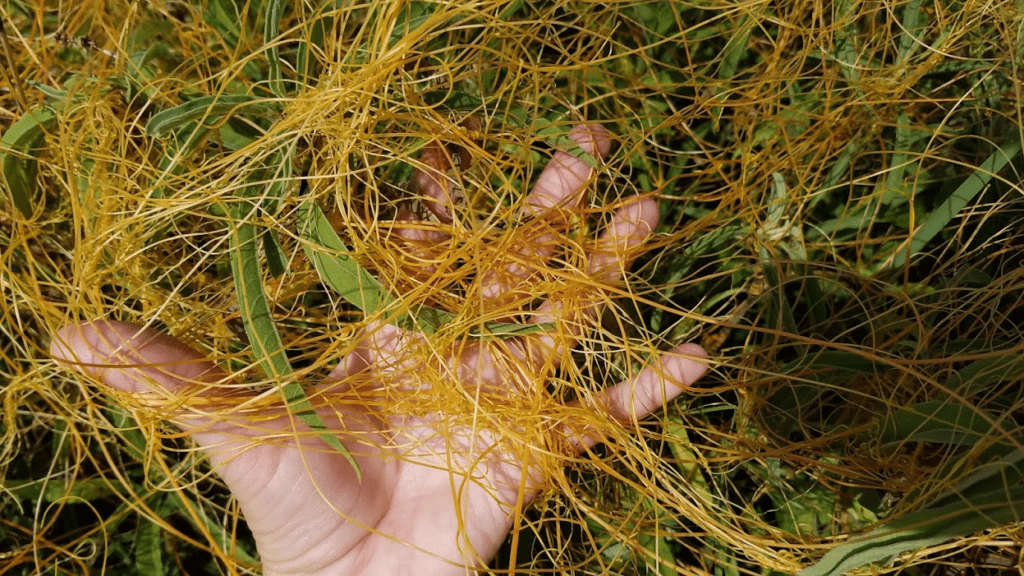Dodder
What plant has no leaves, no roots, and yet can take over a grassland with ease? Dodder. They love open, disturbed areas, which is, of course, most grassland habitats. Grasslands can be extremely competitive arenas for plants. You and all of your neighbors are competing for space, light, and nutrients. Grasses grow fast and tall to reach above wildflowers, while wildflowers bush out to shade out the grass. Parasitic plants, however, cheat to get ahead.
Main Notes and Takeaways
- Has many common names including: wizard’s net, devil’s gut/shoelaces, strangle tare, witch’s hair, or angel hair
- Seeds can remain dormant underground for 20+ years
- Uses tiny root-like structures called haustoria to attach to other plants and feed (more on feeding below)
- Dodder is listed on the United State’s Federal Noxious Weed List

Our Favorite Notes from This Episode
How does dodder feed?
When a young dodder first sprouts it will grow upwards, spinning in circles until it comes in contact with a good host plant. Once that contact is made, it will grow haustoria which pierce into the host’s phloem which is sort of like a plant’s bloodstream. Some plants have evolved defenses against this attack including releasing toxins, strengthening their cell walls, or even killing off the part of the plant being attacked by the parasite. Dodder however is very good at its job and has figured out ways to take control of a host plant’s genes to suppress these responses. Dodder is the first known plant to be able to do this miraculous feat.
Dodder's effect on the environment
A tangled mass of dodder in a grassland can be very detrimental to the plants it feeds off of. Not only is it stealing resources from those plants, but it can also accidentally spread disease. These two factors causes millions of dollars in damage each year in the agriculture industry around the world each year. Even if the plants are not killed, crop yield is often very reduced. Dodder can infest: asparagus, beets, carrots, eggplants, garlic, melons, onion, pepper, potato, tomatoes, fennels, mints, petunias, clover, sunflower, goldenrod, and many other crop, ornamental, and wild plants.
Not all that dodder does is bad however. The tangled web it weaves can actually be used as a plant alarm system. No parasite wants its host to die, and dodder is no exception. Plants love to talk to each other about stresses in the environment such as drought, insect attacks, or to push others out of their space to avoid competition. Dodder is especially helpful in this way as every plant it is touching is able to receive these signals, not just plants of the same species that might be close to each other.
This dramatic video shows up-close footage of how dodder grows and attaches to its host plants.
Sources/Further Reading:
- Dodder Management Guidelines. University of California Agriculture & Natural Resources.
- Penn State. 2018. Agricultural parasite takes control of host plant’s genes. Science X Network.
- Shen, G., Liu, N., et at. 2020. Cuscuta australis (dodder) parasite eavesdrops on the host plants’ FT signals to flower. PNAS 117(3).
- Max Planck Institute for Chemical Ecology. 2017. Dodder: A parasite involved in the plant alarm system. Science Daily.
- Agricultural parasite takes control of host plant’s genes.
- Alonso, J. 22 Aug 2016. Parasite plant check. Mapping Ignorance.
Did you spot an error or have questions about this post? Email Nicole Brown.
